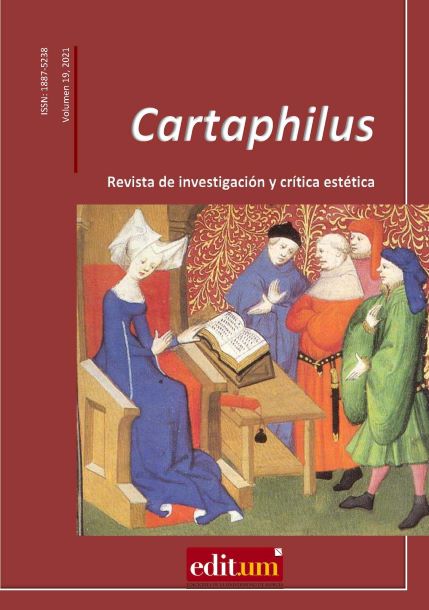The concept of female beauty in Agnolo Firenzuola's work
Abstract
The Florentine writer Agnolo Firenzuola published Dialogo delle bellezze delle donne in the 16th century. This work is presented as an excellent model that allows us to analyze the popularization of the intellectual debates of the time lodged in literary dialogue, a classic genre in vogue among neoplatonists as a vehicle for sociocultural exchange revived during the Renaissance period.
On the one hand, the article aims to analyze the characteristics that, according to the author, women must have in order to be considered beautiful (in the broadest sense of the term) and, on the other hand, the arguments that he uses in favor of gender equality giving rise to a very innovative discourse for its time.
Downloads
-
Abstract541
-
PDF (Español (España))626
References
Benson, Pamela Joseph (1992): The Invention of the Renaissance Woman. The Challenge of Female Independence in the Literature and Thought of Italy and England. University Park: Pennsylvania State University Press.
Bettella, Patrizia (enero de 1998a): “Discourse of Resistance: The Parody of Feminine Beauty in Berni, Doni and Firenzuola”. MLN, 113(1), 192-203. The Johns Hopkins University Press.
Bettella, Patrizia (mayo de 1998b): “Corpo di parti: ambiguità e frammentarietà nella rappresentazione della bellezza femminile nei trattatti di Trissino e Firenzuola”. Congreso Canadian Society for Italian Studies, pp. 1-18. Otawa.
Burckhardt, Jacob (1958): The Civilization of the Renaissance in Italy, vol. II. Nueva York: Harper Colophon Books.
Cropper, Elizabeth (1976): “On Beautiful Women, Parmigianino, Petrarchismo, and the Vernacular Style”. Art Bulletin, 58, 374-394.
Daenens, Francine (1983): “Superiore perché inferiore: il paradosso della superiorità della donna in alcuni trattati italiani del Cinquecento”. En Vanna Gentili (ed.), Trasgressione tragica e norma domestica. Esemplari di tipologie femminili dalla letteratura europea (pp. 11-50). Roma: Edizioni di Storia e Letteratura.
Firenzuola, Agnolo (1562): Prose. Florencia: Giunti.
Flora, Francesco (1945): Storia della Letteratura Italiana, vol. II. Milán: Mondadori.
Jordan, Constance (1990): Renaissance Feminism. Literary Texts and Political Models. Ithaca (Nueva York): Cornell UP.
Paratico, Angelo (10 de mayo de 2017a): “Leonardo Da Vinci, Agnolo Firenzuola e il sorriso della Gioconda”. Gingko. Recuperado de https://www.gingkoedizioni.it/leonardo-da-vinci-agnolo-firenzuola-e-il-sorriso-della-gioconda/ [Fecha de consulta: 20/04/2021].
Paratico, Angelo (2017b): Leonardo da Vinci. Un intellettuale cinese nel Rinascimento. Molinella (Bolonia): Gingko Edizioni.
Pozzi. Giovanni (1984): “Temi, topoi, stereotipi”. En Asor Rosa (ed.), Letteratura italiana. Le forme del testo, vol. 1, Teoria e poesía (pp. 391-436). Turín: Einaudi.
Riviello, Tonia Caterina (1986): Agnolo Firenzuola: the Androgynous Vision. Roma: Bulzoni Editore.
Tonelli, Luigi (1933): L’amore nella poesia e nel pensiero del Rinascimento. Florencia: Sansoni.
Copyright (c) 2022 María-Isabel García-Pérez, Sara Velázquez García

This work is licensed under a Creative Commons Attribution-NonCommercial-NoDerivatives 4.0 International License.
Works published in this journal are subject to the following terms:
1. The Servicio de Publicaciones of the University of Murcia (the publisher) reserves the copyright of the published works and encourages and allows their reuse under the usage licence indicated in point
© Servicio de Publicaciones, Universidad de Murcia, 2015
2. Works are published in the electronic edition of the journal under a Creative Commons Reconocimiento-NoComercial-SinObraDerivada 4.0 International licence (legal text). They may be copied, used, disseminated, transmitted and publicly displayed, on condition that: i) the author and original source of the publication are cited (journal, publisher and URL of the work); ii) the material is not used for commercial purposes; iii) the existence and specifications of this licence for use are mentioned.

3. Self-archiving conditions We allow and encourage authors to electronically disseminate the preprint versions (the pre-review version) and/or post print (the version that has been reviewed and accepted for publication) of their works before they are published as this encourages earlier circulation and dissemination and so a potential increase in their citation and impact in the academic community.




